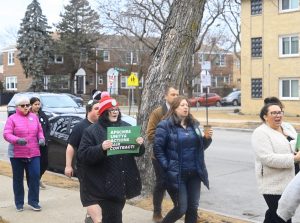Driving into Disaster
Google’s Car Failure
A Google self driving car drives past a double-deck commuter bus at Google’s headquarters in Mountain View, California./Photo by Michael Shick via Wikimedia Commons
March 15, 2016
Some people want to burn rubber on the streets and to be the boss of the road, feeling the wind in their face and the adrenaline through their veins.Yet some just want to ride through the streets worry-free.
Imagine riding in a self-navigating car built to safely maneuver the streets of Chicago. If you think about it, that’s really how a lot of people would want their driving experience to be– deliberate and safe. When it comes to human drivers, we sometimes drive intoxicated or angrily demand to be ahead of someone who’s taking their sweet time trying to turn onto the other side of an intersection. However, Google’s cars have the potential to ease the worries of driving, even if there are a few bumps and crashes along the path.
The electric Google cars are built with tools of three-dimension laser-mapping, global positioning systems and radar analysis to determine surroundings and make decisions in navigation. The cars drive slowly and deliberately to make a safe travel to the passenger’s destination. However, they are not well-equipped to operate in snow or heavy rain. Google may (and should) implement efficient tires appropriate to the weather conditions if the project is to be a success in upcoming years. Despite Google’s efforts to ease the stress of driving, there have been hiccups along the way.
A Google car in Mountain View, California was involved in a crash on Feb. 14. In a video released by the Associated Press, the vehicle, which contained a passenger, can be seen pulling out in an intersection as a transit bus collides with the car at 15 miles per hour. The self-driving car was at a speed of two miles per hour at the time of the collision. No injuries were reported.
The crash had actually happened just four days after the US National Highway Traffic Safety Administration laid responsibilities of a crash on the hands of Google, with the same treatment as that of a human driver.
“NHTSA will interpret ‘driver’ in the context of Google’s described motor vehicle design as referring to the (self-driving system), and not to any of the vehicle occupants,” Reuter’s reported.
Google’s two-seat self-driving cars require set limits of speeds, timings and turn degrees in order to maintain a safe mode of transportation, as designated by the rules of state driving legislation.
It may take a while before drivers and legislation are on board with mass-utilization of self-driving cars.
However, I find myself in a lucky position of not having enough driving experience to properly compare the benefits and setbacks of maneuvering my own car and having a car drive me to school. I have no real preferences to either method. As long as I can get where I’m going safely, I’m a happy passenger.








